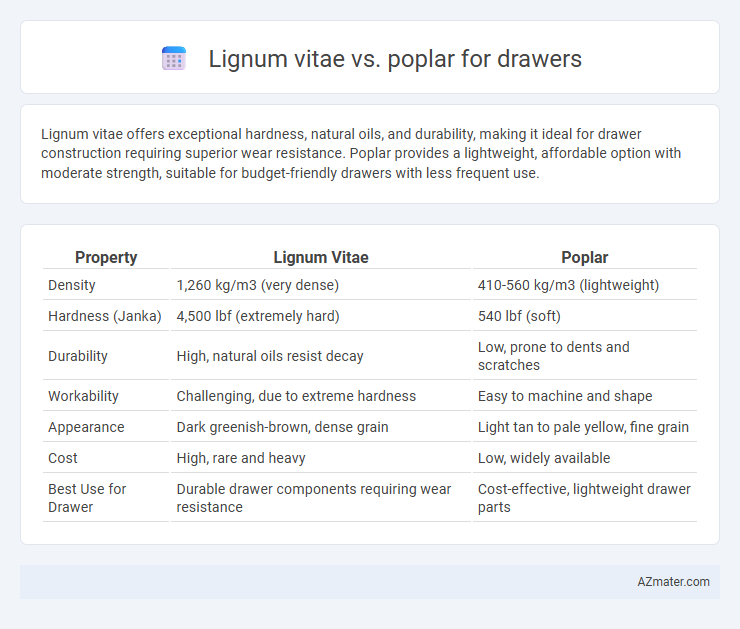Lignum vitae offers exceptional hardness, natural oils, and durability, making it ideal for drawer construction requiring superior wear resistance. Poplar provides a lightweight, affordable option with moderate strength, suitable for budget-friendly drawers with less frequent use.
Table of Comparison
| Property | Lignum Vitae | Poplar |
|---|---|---|
| Density | 1,260 kg/m3 (very dense) | 410-560 kg/m3 (lightweight) |
| Hardness (Janka) | 4,500 lbf (extremely hard) | 540 lbf (soft) |
| Durability | High, natural oils resist decay | Low, prone to dents and scratches |
| Workability | Challenging, due to extreme hardness | Easy to machine and shape |
| Appearance | Dark greenish-brown, dense grain | Light tan to pale yellow, fine grain |
| Cost | High, rare and heavy | Low, widely available |
| Best Use for Drawer | Durable drawer components requiring wear resistance | Cost-effective, lightweight drawer parts |
Introduction to Lignum Vitae and Poplar for Drawers
Lignum Vitae is a dense, durable hardwood renowned for its natural oils and exceptional resistance to wear, making it ideal for high-quality, long-lasting drawers. Poplar, on the other hand, is a lightweight, softer wood commonly used for drawer components due to its affordability and ease of machining. The choice between Lignum Vitae and Poplar depends on balancing durability and cost-effectiveness in drawer construction.
Physical Properties: Lignum Vitae vs Poplar
Lignum Vitae is significantly denser and harder than Poplar, boasting a Janka hardness rating of approximately 4,500 lbf compared to Poplar's 540 lbf, making it far more resistant to dents and wear. Its natural oils provide exceptional durability and resistance to moisture and decay, while Poplar, being a softer hardwood with a lower density (about 510 kg/m3 versus Lignum Vitae's 1,260 kg/m3), lacks this natural protection and is more susceptible to damage and swelling. These physical properties make Lignum Vitae ideal for high-stress applications such as drawer components requiring long-lasting strength and resistance, whereas Poplar is better suited for lightweight, low-impact drawer applications.
Durability and Longevity Comparison
Lignum vitae offers exceptional durability and longevity for drawers due to its dense, oily composition, making it resistant to wear, moisture, and pests. Poplar, while more affordable and easier to work with, has moderate durability and is prone to dents and scratches, leading to a shorter lifespan in high-use furniture. For long-lasting drawer construction, Lignum vitae significantly outperforms Poplar in terms of strength and resistance to environmental damage.
Workability and Ease of Machining
Lignum vitae is a dense, oily hardwood known for its exceptional durability but presents challenges in workability due to its hardness and tendency to blunt tools quickly. In contrast, poplar is a softwood renowned for its ease of machining, allowing for smooth cutting, shaping, and sanding, making it ideal for drawers that require precision and speed during production. While lignum vitae offers superior strength and wear resistance, poplar's workability minimizes effort and time, resulting in efficient manufacturing for drawer components.
Weight and Density Differences
Lignum vitae, known as one of the densest hardwoods, has a density ranging from 1,260 to 1,370 kg/m3, making it significantly heavier than poplar, which has a density of approximately 400 to 510 kg/m3. The substantial weight difference impacts drawer construction, as lignum vitae provides excellent durability and resistance to wear but adds considerable heaviness, whereas poplar offers lightweight ease of use and flexibility but with less structural robustness. Choosing between these woods depends on balancing the need for strength and longevity against the practicality of weight in drawer applications.
Aesthetic Qualities and Grain Patterns
Lignum vitae showcases a rich, dark brown color with distinctive greenish or black streaks, offering a luxurious and sophisticated aesthetic for drawer construction. Its tight, interlocking grain pattern provides a smooth finish with a subtle sheen, enhancing the visual appeal and durability of drawers. In contrast, poplar features a lighter, creamy white to yellowish tone with a relatively straight, uniform grain, which lends a clean, minimalist look ideal for painted or stained drawer fronts.
Cost and Market Availability
Lignum vitae is a dense hardwood known for its durability and natural oils, but it comes with a significantly higher cost and limited market availability due to slower growth and restricted sourcing. Poplar, by contrast, is a more affordable and widely available soft hardwood, favored for its workability and lower price point in drawer construction. Choosing between the two depends on budget constraints and the importance of durability versus cost efficiency in drawer manufacturing.
Environmental Impact and Sustainability
Lignum vitae is a dense, slow-growing hardwood known for its durability and natural oils, which reduce the need for chemical treatments, but its limited availability raises concerns about overharvesting and deforestation. Poplar, a fast-growing, widely cultivated softwood, offers a more sustainable option with lower environmental impact due to its rapid renewability and ability to be grown on managed plantations. Choosing poplar over lignum vitae for drawers supports sustainable forestry practices and reduces ecological strain while still providing functional performance.
Best Applications for Each Wood Type
Lignum vitae, known for its extraordinary density and natural oils, excels in heavy-duty drawer applications requiring exceptional durability and resistance to wear, such as marine or industrial furniture. Poplar, with its light weight and smooth grain, is ideal for budget-friendly, decorative drawers in residential settings where ease of painting and finishing is prioritized. Choosing Lignum vitae enhances longevity in harsh conditions, whereas Poplar supports versatile design aesthetics and affordability.
Final Recommendations: Choosing the Right Wood for Drawers
Lignum vitae offers superior durability, density, and natural resistance to wear, making it ideal for heavy-use drawer applications requiring long-lasting performance. Poplar is a lightweight, cost-effective option with good workability and smooth finish, suitable for decorative or light-use drawers where budget and ease of machining are priorities. Choose Lignum vitae for strength and longevity; opt for Poplar when affordability and ease of customization are key factors.

Infographic: Lignum vitae vs Poplar for Drawer
 azmater.com
azmater.com